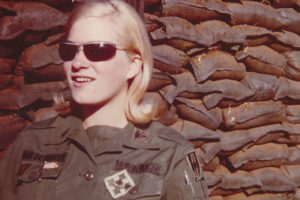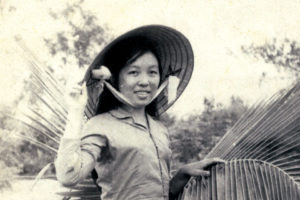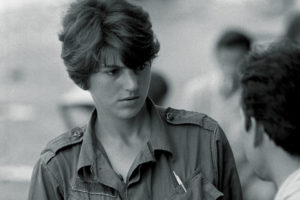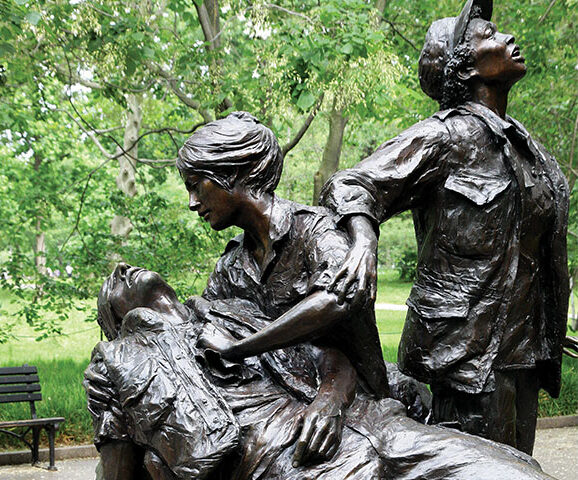When women participate in a war, they exhibit a particular kind of courage, to face not only the dangers of battle but also the negative opinions—perhaps even their own—of those who don’t believe they are capable of enduring war’s grueling difficulties. In Courageous Women of the Vietnam War, author Kathryn J. Atwood profiles 14 women who served as medics, journalists, resisters and revolutionaries. Here are the stories of an American nurse, a North Vietnamese surgeon, and an Australian correspondent.
Lynda Van Devanter
—U.S. Army Nurse
Lynda Van Devanter was in her last year of nursing school in Baltimore when the war in Vietnam began to press into her consciousness. “If our boys were being blown apart, then somebody better be over there putting them back together again,” she later wrote. “I started to think that maybe that somebody should be me.”

When an Army recruiter came to the nursing school in January 1968, Van Devanter signed up. After graduation, she drove to Fort Sam Houston, Texas, for basic training. The recruits repeatedly practiced what to do in a “mass-cal” (mass casualty) situation, when a hospital would be suddenly overwhelmed with wounded men.
During a mass-cal, nurses would have to triage casualties, quickly assessing each wounded man and taking one of three actions: send him immediately to surgery; have less-serious cases wait for surgery; or ease his pain before allowing the inevitable to happen.
“Essentially, we were deciding who would live and who would die,” Van Devanter wrote later. It was a difficult concept for her. She had become a nurse to save lives. But her instructors made it clear that if precious time was spent on one hopeless case, those with survivable wounds might lose their chances.
In June 1969, the aircraft carrying Van Devanter and 350 men began its descent into South Vietnam. When the plane began “jerking wildly,” luggage fell from the overhead racks. Terrified, Van Devanter looked out the window. She could see explosions. “If there had ever been any cockiness in me before this trip began, there sure wasn’t any now,” she wrote later. “In its place was a cold, hard realization: I could die here.”
Van Devanter’s destination was the 71st Evacuation Hospital in Pleiku province, near the Cambodian border, an area of heavy combat. She would remember her first days in the operating room as a “blur of wounded soldiers, introductions to new colleagues, and almost constant surgery” during 12-hour shifts. A week later, she experienced a mass-cal for the first time.
Describing it later, she wrote: “The moans and screams of so many wounded were mixed up with the shouted orders of doctors and nurses. One soldier vomited on my fatigues while I was inserting an IV needle into his arm. Another grabbed my hand and refused to let go. A blond infantry lieutenant begged me to give him enough morphine to kill him so he wouldn’t feel any more pain. A black sergeant went into a seizure and died while we were examining his small frag wound.”
As she spent more time at the hospital, Van Devanter had to work harder to remind herself that she was in Vietnam “to save people who were threatened by tyranny.” But she found that belief increasingly difficult to maintain as she heard stories of “corrupt South Vietnamese officials, U.S. Army atrocities, and a population who wanted nothing more than to be left alone so they could return to farming their land.”
In letters home, Van Devanter began to express her doubts about how the United States was handling the war. “It would be a lot easier if our government would just make up its mind,” she wrote. “We should either pull out of Vietnam or hit the hell out of the NVA [North Vietnamese Army]. This business of pussyfooting around is doing nothing but harm. It’s hurting our GIs, the people back home, and our image abroad.”
Yet she was also proud of her work: “I don’t think there are many other places where you can feel as needed in nursing…. For the first time in my life, I feel like I have to keep going or people might not survive.”
In June 1970, when her yearlong tour was up, Van Devanter boarded her “freedom flight” out of Vietnam. “As the jet took off, I was filled with the most exhilarating sensation of my life…like the weight of a million years had been suddenly lifted from my shoulders,” she said.
But when the airport bus dropped Van Devanter and others off at the Oakland Army Terminal at 5 a.m., they had no way of immediately reaching San Francisco International Airport, 20 miles away. Van Devanter decided to hitchhike. Dressed in her uniform, she watched car after car whiz by. Some of the drivers screamed obscenities at her; others threw garbage. One finally took pity on her. Eventually, she made it home to Virginia.
On her first night back, Van Devanter showed to her family a slide show of Vietnam photos. When she came to photos of the operating room, her uncomfortable parents asked if she could show them something “less gruesome.” Van Devanter hid the slides in the back of her closet. “I had learned quickly,” she wrote later. “Vietnam would never be socially acceptable.”
Years passed, and Van Devanter continued working in nursing. But she suffered intense emotional pain she couldn’t shake off or begin to comprehend. She eventually married a close friend who created a radio documentary called Coming Home, Again, which related Vietnam veterans’ experiences. One of the men involved in the project asked Van Devanter to be interviewed for the documentary. Then he asked her to create a women’s organization with Vietnam Veterans of America.
Van Devanter also began studying post-traumatic stress disorder and realized it had been part of her life for years. Many female veterans were also suffering from trauma, and the VVA’s women veterans project gave them a voice and helped them realize they were not alone. Van Devanter was the first American military nurse to publish a widely read Vietnam memoir, titled Home Before Morning. The book helped inspire the creation of China Beach, an award-winning 1988-91 television series about an American evacuation hospital in Da Nang during the Vietnam War. VVA honored Van Devanter with its Excellence in the Arts award in 1982 and its Commendation Medal in 2002.
In her later years, Van Devanter suffered from a vascular disease she believed was related to her exposure to Agent Orange. She died at age 55 on Nov. 15, 2002.
“Lynda’s book stands as one of the most powerful, evocative, and influential Vietnam War memoirs,” wrote Marc Leepson, the arts editor of the VVA’s national publication, in an obituary for Van Devanter. “Home Before Morning changed people’s attitudes about the women who served in the Vietnam War, especially the nurses who faced the brutality of the war every day and whose service was all but ignored during the war and in the years immediately after.”
Dang Thuy Tram
—Communist Field Surgeon
On Jan. 1, 1969, Dr. Dang Thuy Tram recorded in her diary a message Ho Chi Minh had sent to those fighting for the Communist cause: “This year greater victories are assured at the battlefront. For independence—for freedom. Fight until the Americans leave, fight until the puppets fall. Advance soldiers, compatriots. North and South reunified, no other spring more joyous.”

Tram had thought of little else since Dec. 23, 1966, when she left her family in Hanoi and began the arduous, dangerous trek down the Ho Chi Minh Trail. Three months later, Tram reached Duc Pho, a district in the south-central Quang Ngai province. The people there had heavily resisted the French during the First Indochina War and were now fighting the Americans and South Vietnamese forces. Tram was assigned the job of chief surgeon in a Duc Pho clinic, working to save Viet Cong and NVA soldiers.
While Tram derived great satisfaction from her work, she was troubled by her thwarted attempts to be accepted into the Communist Party. Tram believed that being a party member would allow her to more effectively serve the Communist cause. To her great frustration and sorrow, Tram’s educated background branded her as bourgeois—that is, middle class and materialistic—and therefore unworthy of membership in the Communist Party.
Tram’s dedicated medical work and obvious devotion to the cause, however, eventually gained the respect of local Communist Party leaders. On Sept 28, 1968, she was finally accepted, writing in her diary, “My clearest feeling today is that I must struggle to deserve the title of ‘communist.’”
During her service, Tram found it difficult to not befriend the young men fighting for Vietnam’s unity. “I have a physician’s responsibilities and should maintain some degree of objectivity,” she wrote, “but I cannot keep my professional compassion for my patients from becoming affection…. Something ties them to me and makes them feel very close to me.”
In late March 1969, she transferred to a clinic that treated civilian and military cases. Americans considered the area a “free-fire zone,” an area with supposedly no friendly civilians, so anyone remaining was considered the enemy and could be fired upon. Whenever American units approached, clinic personnel had to flee. They were never really safe, and throughout the summer, the medics and their wounded were constantly on the move as the intense fighting grew closer.
On July 16 Tram witnessed a nearby airstrike: “Where each bomb strikes, fire and smoke flare up; the napalm bomb flashes, then explodes in a red ball of fire, leaving dark, thick smoke that climbs into the sky.”
During such raids, Tram worried about the people she knew and loved. “From a position nearby, I sit with silent fury in my heart,” she wrote. “Who is burned in that fire and smoke? In those heaven-shaking explosions, whose bodies are annihilated in the bomb craters? Oh, my heroic people, perhaps no one on earth has suffered more than you.”
From underground shelters and bunkers, Tram had heard American troops but never encountered them face-to-face. Sent on a nighttime emergency mission, she once walked through hostile territory with an armed guard. “Perhaps I will meet the enemy, and perhaps I will fall, but I hold my medical bag firmly regardless,” she wrote in her diary.
On June 2, 1970, Tram’s clinic took a direct hit, which killed five patients. Ten days later, American troops attacked the medics at a different location. No one was injured, but the medics had to move again.
A few days later, Tram and two Vietnamese civilians were walking on a trail with a soldier when she came face-to-face with a group of Americans. Local villagers later found her body; she had been shot in the head.
Tram’s diaries fell into the hands of Fred Whitehurst, an American working with a military intelligence unit. Assigned to destroy enemy documents, Whitehurst was about to throw the diaries in a fire when his South Vietnamese interpreter, Sgt. Nguyen Trung Hieu, stopped him. “Don’t burn this one, Fred,” he said. “It has fire in it already.” Hieu read aloud the entries to Whitehurst, who was moved and kept the diaries when he left Vietnam in 1972.
In 2005, Whitehurst located Tram’s family and gave them the diaries. Later that year, they were published in Hanoi as one volume, which became a best-seller. Young Vietnamese readers, who had learned about the war only from textbooks or overly formal diaries, were taken by Tram’s unpretentious voice, describing a warm, intelligent and occasionally self-doubting young person caught up in the horror of war. In 2007, Tram’s diary was translated into English and published under the title, Last Night I Dreamed of Peace.
Kate Webb
—Captive Journalist
In March 1967, Kate Webb left her newsroom job in Sydney, Australia, and headed for Vietnam. “It was simply the biggest story going, and I didn’t understand it,” the 23-year-old New Zealand-born journalist wrote.
After a few weeks of writing articles for Vietnamese newspapers, Webb got a freelance job with a GI newspaper. This widened her options, giving her formal accreditation with the Military Assistance Command, Vietnam (MACV, which oversaw all U.S. combat forces in South Vietnam), an extended visa, access to daily military briefings and the right to accompany men into battle.
On Jan. 30, 1968, Webb rushed to the besieged U.S. Embassy in Saigon to cover the Communists’ Tet Offensive, becoming the first wire correspondent to do so. Her articles

appeared in The New York Times, Newsweek and Time. Webb discovered that she possessed a crucial trait for a war correspondent: the ability to “function and write amid the knife-edge fear of battle.”
Webb’s curiosity eventually led her to Cambodia, where the U.S. Air Force was covertly bombing North Vietnamese and Viet Cong sanctuaries. On March 18, 1970, Cambodian Prime Minister Lon Nol deposed Prince Norodom Sihanouk and allied himself with the United States. But Lon Nol had to contend with an enemy within the country—the Khmer Rouge, Cambodian Communists led by the brutal Pol Pot.
On the night of April 6, 1971, Chea Ho, a Cambodian freelance reporter, told Webb that Cambodian paratroopers were likely to clash with North Vietnamese soldiers along Highway 4 the following day. Taking with her a Cambodian translator, Chhim Sarath, Webb drove to the rear lines and continued on foot, hoping to report firsthand stories from the front. A half-hour later, gunfire seemed to “burst from all sides,” forcing Webb and Chhim Sarath to seek cover in a roadside ditch. They huddled there alongside four other noncombatants.
Once the fight was over, the civilians tried to quickly move away from the area. But later that morning, they came face-to-face with two young North Vietnamese soldiers, who motioned for them to drop everything. Terrified, their hands in the air, the civilians all cried out, “Nha bao” (journalist), and “Nuoc” (water).
The soldiers stripped the civilians of their belongings, tied their hands behind them with baling wire that cut into their skin, linked them into two groups of three, and moved them into a dark bunker. Webb feared a live grenade would follow.
But instead, the soldiers forced the group to march. “I tasted it—the feeling of being a prisoner—underneath the burning thirst, the new loneliness in me,” Webb wrote. And although she felt certain they would be killed, she couldn’t resist her reporter’s “compulsive documenting of every detail” of her experience.
After a blurred number of days and nights on foot, the prisoners and their captors stopped in a clearing. One by one, the soldiers singled out each prisoner for what they said were interviews. They took Webb to a military man who was in his 60s. Sitting before him, her hands shook with fear.
“Do not be afraid,” the interpreter said. “You are in the hands of the Liberation Armed Forces (the army of the Southern Vietnamese Communists).” He told Webb to speak slowly so he could understand her English.
“An odd thing happened as question followed question and the young interpreter struggled to translate from English,” she wrote later. “I found myself thinking of the senior officer interrogating me as a professional soldier. The flipside of that was that I stopped feeling like a filthy, scared prisoner…and like a professional reporter instead. He was taking what the war dealt out to him, and I was taking what the war dealt out to me.”
After several days with little rest and food, the prisoners were in poor health. They had lost too much weight, and Webb was experiencing severe symptoms: vomiting, diarrhea, fever and shivering. But she felt more disturbed by her mental state. Living inside “the gray limbo of the prisoner…with no links to the living world” made her fear she was quickly descending into a dark place.
Finally, following a “tense new round of interrogations” at the same location, the soldiers told the prisoners they were being released. Webb didn’t allow herself to believe it. “Hope, we had fast learned, was as treacherous as an oasis mirage, and as cruel,” she said.
The soldiers took the prisoners to the command hut, seating them on wooden benches in a semicircle around a table. An officer stood behind the table and began to read from an official document. Webb felt so ill that she had trouble concentrating on his exact words, but he appeared to be announcing their release. Six guards then took them away.
After two days, Webb woke in the middle of the night and saw the others scrambling to gather their things. Amid hasty goodbye handshakes, the guards left their prisoners “alone in the dark on a roadside in no-man’s land.”
Terrified, they began walking and soon saw a group of Lon Nol’s soldiers. Webb waved a white cloth, and they all repeatedly yelled, “Kassat” (press).
They had been in captivity for 23 days.
As Webb recovered from two types of malaria, her transition from captivity to freedom was perhaps the strangest and in some ways the most difficult aspect of her experience.
She found quite disturbing the deeply divided American press. Webb was shocked when, speaking to the members of the Washington Press Club, she was told that a field reporter was “morally bound” to take a pro-war or pro-peace stand. Webb argued that a field reporter’s job was not to choose sides but only to report what was happening and what people were saying, feeling and doing on the ground. “Without that hard, unbiased input,” she said, there was “nothing to opinionate, or stand, on.”
On May 13, 2007, Webb died from cancer in Sydney at age 64. Her New York Times obituary quoted a fellow Vietnam reporter, Pulitzer Prize–winning Peter Arnett, who honored Webb as a “fearless action reporter” and “one of the earliest—and best—women correspondents of the Vietnam War.”
Kathryn J. Atwood is also the author of Women Heroes of World War I, Women Heroes of World War II, and Women Heroes of World War II: The Pacific Theater.





